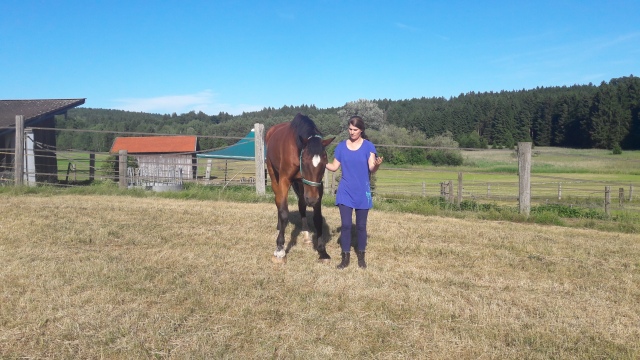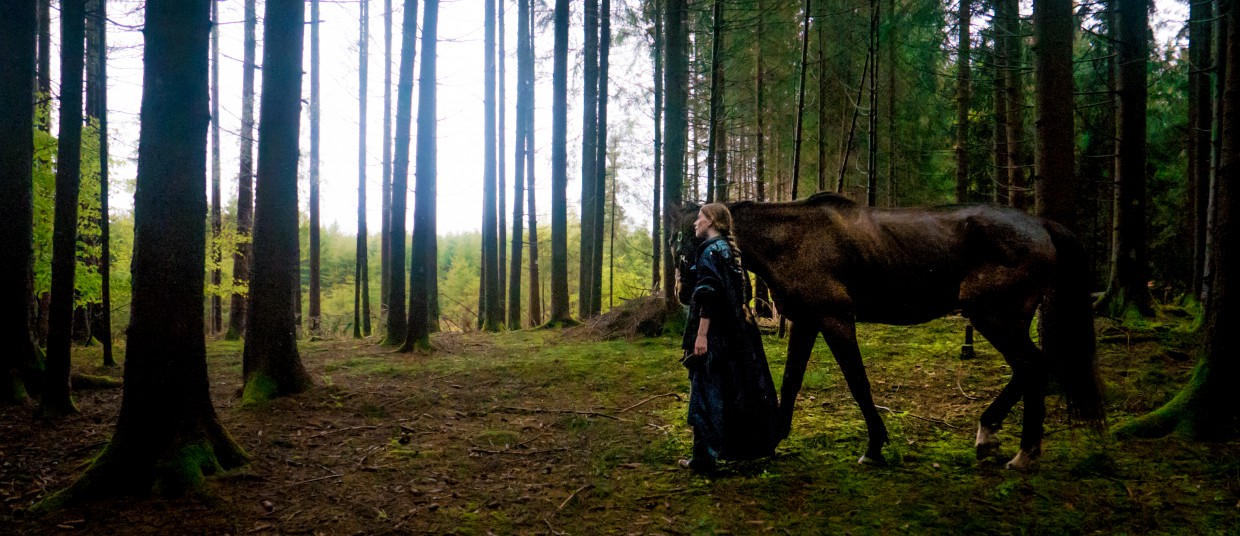I started out my previous post on groundwork with “the Why”: your horse’s health.
A short excursion into my recent “Pony Fitness Training” members will show you what I mean:
There’s the young little, nervous mare with a history of rather bad back pains due to too aprupt in-saddle training combined with a weakly muscled constitution and an ill-fitting saddle.
There’s the obese Haflinger with a history of problems in the lumbosacral area, weak back-stabilising muscles combined with immense pull caused by a huge belly plus earth’s gravity. Her previous saddle was too long and put additional pressure on the lumbar area (saddle fit seems a theme here, maybe for a future post…).
I’ve just started work with a gentle-natured Arabian mare who’s of a certain age already and struggles with lung issues – not exactly easy to build muscle mass.
And then there’s the super-opinionated alpha mare who’s strong and knows it, but – now also past the 20 – started developing issues with her legs, a swollen tendon sheath in one back leg and a suspiciously looking superficial flexor tendon in the opposite front leg. Possibly aided ailments by her strong believe that relaxation leads to her and her herd being devoured by tigers, instantly. This is not an exaggeration, the lady’s neck, withers and shoulder areas are rock-hard and bending on a 20m circle is advanced yoga to her.
Of course, there’s also my 26-year-old, 177cm tall ex-show jumper, Wesley. Still around, alive and kicking!
Anyone who knows retired jumpers and/or very tall oldies, knows your troubles are with the legs: Degenerative arthritis in hocks lead to dragging toes and altered protraction with a lateral curve instead of taking the leg straight to the front. This altered movement pattern leads to a chronic irritation of the tendon sheaths. A problem in a hindleg will, over time, lead to another, compensatory issue in the opposite front leg and so on…

You can guess where I’m going with this, the above mentioned list of “fitness club members” can all greatly benefit from in-hand work, with some – at times – it might even be required to only do groundwork for a while before mounting them again.
This might be rather clear for the back-issue candidates – no need for much medical training to understand that the weight of saddle and rider might not be the best idea until they’re better again.
But this also goes for the weak lungs and especially for the troublesome legs. See, most horses I know aren’t very well balanced – and by a horse’s balance it’s important to regard all 4 dimensions: front to back as well as side to side. Secondly, and let’s face it, none of us are truly balanced, fantastically fine riders that never disturb our horses when mounted and never throw them off-balance. No, riding is a lifelong process of learning and improving.
And what happens if I have a chubby horse that is hollow on the right and poorly balanced? It will throw its weight onto the outside, in this case left front leg whenever going into a right-hand bend, drifting to the outside of the bend. Now add a rider that might be just a tad crooked or stiff in the hips, maybe with a quite long upper body. The two ride into their right-hand 10m volte at the trot, the chubby horse with all of its own, plus the rider’s weight on the front left leg might still not break anything – now think of the same mechanics when going into a left-hand volte… see the problem?
I study physiotherapy for horses next to my job(s), so of course, I see a lot more issues than most owners would, and I hope this helps me in becoming a better trainer and help owners adjust their training routines, workload and assessment of their own horses.
And to help you become a better fitness trainer for your horsey, I’d like to go into some practical pointers and exercises on “the How” of groundwork.
In my teaching horse owners the basics, I came to the conclusion that many riders are quite willing to improve their horses’ health by working with them from the ground, but very often don’t quite know how to go about it.
So, let’s start out as if you’ve never even led a horse:
First of all, I try and practice leading. Yes, leading a horse – by a lead line, neck holder or its mane if you guys can communicate really well.
And I don’t mean the pulling-the-donkey-after-you to the practice area kind of leading. Sure, when horses are unsure or scared, they are allowed to hide a little behind their human. But this is a working exercise in an arena or paddock your horse knows well.
Practice walking together in the partner position, meaning shoulder-on-shoulder.
This has the advantage that you can see your horse’s face, eyes and ears, make sure you don’t accidentally over-bend the poll and neck (happens a lot!) and can easily reach the girth area or shoulder with your hand and the hindquarters with your whip.
I always recommend working with a whip, this way you can ensure your horse works from back to front, steps under properly and it can be very useful for giving directions and signals your horse understands well. It really is just an elongation of your arms, or when used as a driving aid as a replacement for your seat and leg aids.
Now, your position and body language are crucial here. You want to carry yourself upright and controlled, think “ballerina” – your horse will mirror you, so don’t slump and drag your feet in the sand.

Your position should be similar to when mounted: your shoulders aligned with the horse’s and your gaze always in the direction you are travelling.
Try it out: walk your horse that way, you might need to drive a little with the whip from behind to get your horse shoulder-on-shoulder with you. Good.
Now, try and turn towards your horse. Did your horse turn to you?
What’s super-important with all of your groundwork exercises: change sides regularly, as your horse will naturally always bend towards you.
For session one of your little groundwork course, you practice the basics:
Leading in partner position on both sides and both hands, meaning when walking right-hand-side, you walk at the right shoulder of your horse – when walking left-hand-side, you walk at the left shoulder of your horse.
First along the side of the arena with many long straights, then you can gradually go on to practice the 20m circle and eventually some 10m – 6m voltes together.
Here you are already working on your horses balance and bend, when driving correctly from behind you also help it with it’s front-back balance by motivating it to step under and rise a little out of its shoulders.
When this works well, you can start adding stops and starts. Be patient here and try and use minimum aids with everything you ask. Only when breathing out, slowing down and planting your feet in the ground doesn’t cue your partner to halt with you, can you use some helping pointers.
Next time you ask for the halt, just position your whip parallel in front of its chest. Make sure you stay with your hips, shoulders and eyes in the direction of travel, no turning to your horse. Use your body and voice cues.
And then praise, a lot! Praise for every try of understanding you, soon your horse will think groundwork sessions are super-fun!
When halts and starts work well (make sure never to pull your horse forward, drive from behind and use your body’s energy, stance and upper-body positioning to signal “walk”), you might add a few steps backward.
Practice this first on the straight, with a wall or fence on one side. Most horses already move backward when you lean your upper body back, no need to pull on the lead line – and if they are a bit “slow”, just tuck on it lightly, then loosen as soon as they move back only a fraction. Release is instant praise!
Should this not work because your horse is exceptionally opposed to going backward, you can wiggle your whip in front of its chest a little to indicate a backward movement.
Now, try combining it all in quick sequences, walk a few curves and bends, halt every now and then (remember to prepare well by breathing out and using your voice), then go backwards together (you are still facing forward, leaning back a little), and then move forward again by driving the hind.
This will help your horse pick up more weight in the hindquarters, step under, round its back and develop strength by pushing forward from behind.
You can refine all of this by adding hand and / or whip signals to your little dance.
For example:
- hand up or whip vertical means “halt”

- hand or whip signalling a “back movement” means “please move backwards with me”

- moving hand and /or whip energetically from back to front means “let’s run /move”
- pointing to one side or the other indicates a bend or curve in that direction
Always end your sessions with something the horse already knows well, so it can feel good about itself and you have a reason to praise it before calling it a day.

Well done, guys! You are on the right track!
Next time:
- correcting over-bend on the circle
- my horse falls inside the bend with its inner shoulder!?
- helping with bad posture, aka. the dreaded “on-the-forehand”
- trot-walk transitions and shoulder-in from the ground






Nice post. I think ground work can be very beneficial.
LikeLike
Thanks Anne. What exercises do you practice with Biasini et all?
LikeLiked by 1 person
I have found the Tellington exercises work well with him: just the basic walk. Halt , back up and all the labyrinth and the walking over poles ( the fan). He can be a nervous horse and the Tellington ground work and Tellington touch really helps him.
LikeLiked by 1 person
Pingback: Groundwork: the How – Part II – horseharmonyblog